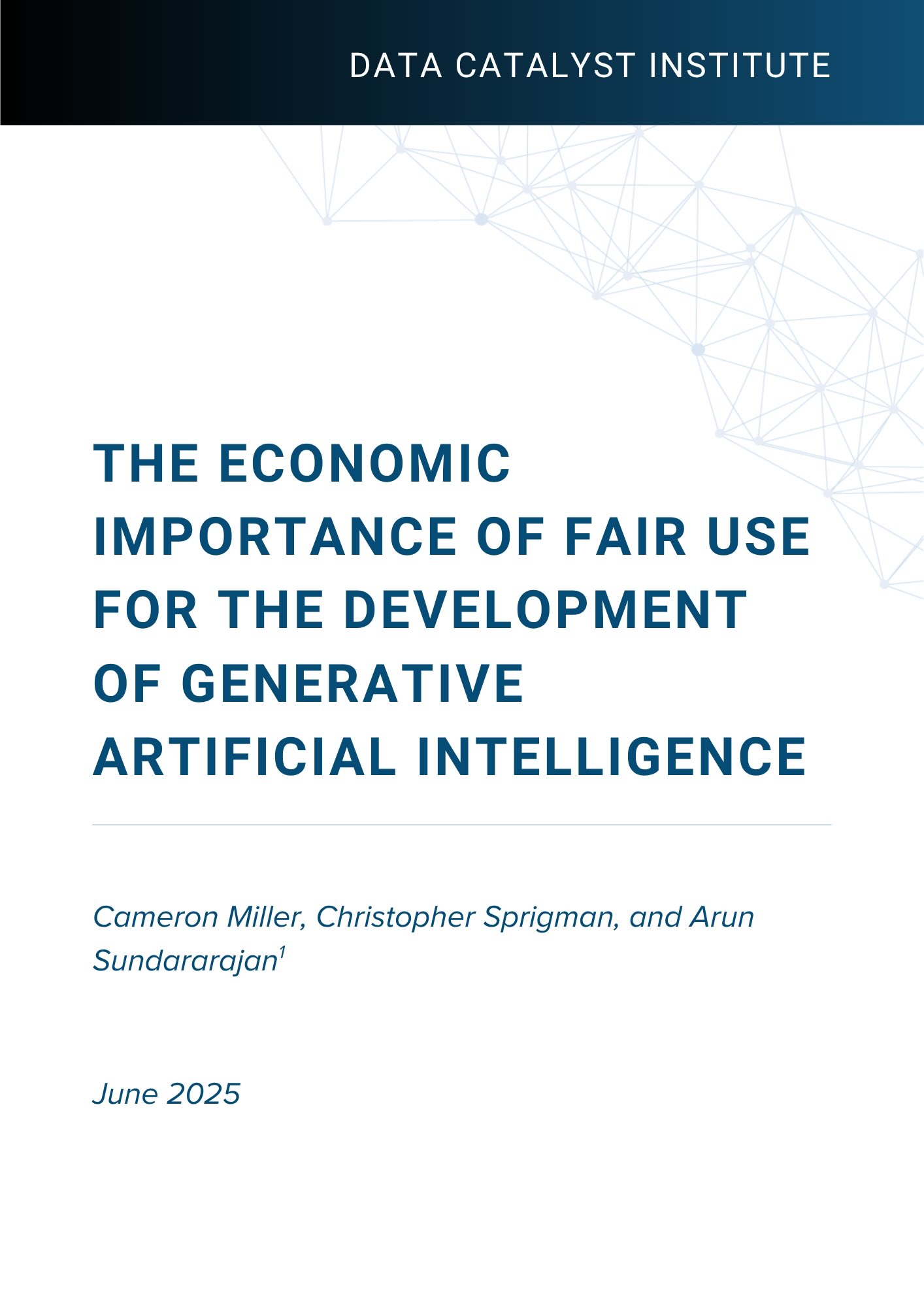
The Economic Importance of Fair Use for the Development of Generative Artificial Intelligence
June 2025
Generative AI (GenAI)—artificial intelligence systems that can create new and original content like text, code, images, music, and even novel molecules—represents a pivotal technology for U.S. economic competitiveness and global leadership. Paradigm-shifting innovations like GenAI are rare; only a handful of prior technologies like the steam engine, electricity, and the internet have been termed a “general purpose technology.” Given its potential to transform industries ranging from healthcare to national defense, GenAI’s development is increasingly critical to maintaining America’s technological edge. Industry research estimates that GenAI could add anywhere from $2.6 to 7.9 trillion to the global economy annually through 2040, with the potential to transform over 80% of existing occupations. Substantial productivity gains from GenAI in several high-profile industries have already been demonstrated—26-39% returns in pharmaceutical R&D, 27-35% improvements in financial services—signaling that whatever nation leads in GenAI development will shape the global economic trajectory for decades to come.
This paper explains how fair use—a cornerstone of U.S. copyright law that permits certain uses of copyrighted works without authorization, especially when they provide broader public benefits—can unlock GenAI’s full potential. Because GenAI systems learn to create new content by analyzing billions of existing works, fair use reduces the inefficiencies and burdens of licensing regimes by enabling developers to train these systems without negotiating with millions or billions of copyright holders, avoiding ruinous if not impossible transactional costs and fostering innovation. By providing a flexible framework that balances copyright protections with innovation, fair use has historically fostered transformative technological advances. Its application to GenAI development is critical for sustaining the technology’s continued advancement.
Our analysis rests on three key themes, all of which are supported by extensive empirical evidence.
- The Transformative Economic Impact of GenAI: Industry-wide data, organizational case studies, and academic studies demonstrate significant productivity gains and value creation due to GenAI across the economy, with benefits for both large enterprises and small businesses. In addition to these direct gains, GenAI is already generating measurable scientific and technological spillovers—accelerating discovery, enhancing research efficiency, and catalyzing innovation across domains. These broad-based effects are characteristic of a general-purpose technology and suggest compounding long-term benefits.
- Fair Use as a Critical Enabler of Innovation and U.S. Technological Leadership: Investment patterns and startup activity show that fair use jurisdictions, particularly the United States, have attracted more GenAI-related investment and fostered greater innovation.
- Economic Inefficiencies of Alternative Approaches to Fair Use: Comparative analyses of copyright licensing regimes, statutory exemptions, and liability-based approaches—particularly those considered or implemented outside the United States—reveal significant economic barriers that would impede GenAI development and risk U.S. technological leadership.
The evidence supporting these themes is compelling. For example, our analysis shows how fair use jurisdictions attract substantially more GenAI investment: venture capital investment in GenAI firms between 2019 and 2024 flowed overwhelmingly to the U.S., reaching $53.6 billion compared to just $6.8 billion in Europe. Granted, VC funding allocation depends on several factors and legal standards, but the inadequacy of alternative copyright approaches suggests that these legal standards are correlated with thriving investments in AI. This pattern holds true for the most promising AI startups as well – of the top 50 such companies identified by Forbes in 2024, 39 were based in the U.S., accounting for $33 billion of the $34.7 billion total investment in these leading firms.
Our analysis also shows that there would be substantial economic costs associated with alternative policies to fair use. Licensing schemes for millions of works would be prohibitively expensive. Copyright exemption systems that feature prescriptive rules rather than more flexible standards are structurally less amenable to technological change. Expanded liability frameworks could expose developers to potential damages ranging from $750 million to $150 billion per model (see section 3.2.4 — The Economic Risks of Expanded Liability), effectively halting model development in the U.S., particularly by startups and smaller AI firms.
At this critical juncture, policymakers have an opportunity to reinforce this legal framework that has long supported American innovation. The evidence shows that maintaining the flexibility of fair use while fostering practical solutions is crucial to realizing GenAI’s transformative potential. This balanced approach will help ensure that the United States can secure its position as a global leader in artificial intelligence while delivering benefits to society for generations to come. Given the global competition to lead AI, delays in upholding fair use principles for GenAI development could cede technological advantages to foreign competitors, as early leaders benefit from cumulative investments and innovations that are incredibly hard to overcome once established.

The Economic Importance Of Fair Use For The Development of Generative Artificial Intelligence
Cameron Miller, Christopher Sprigman, and Arun Sundararajan
June 2025